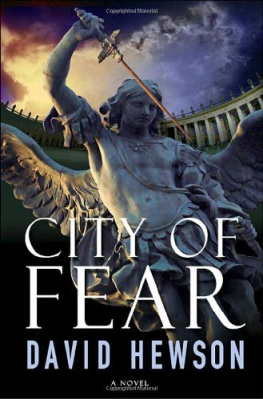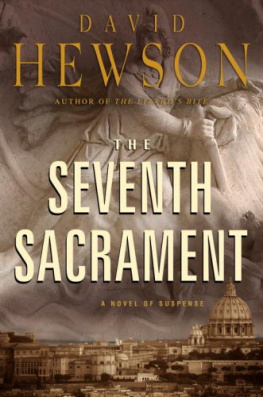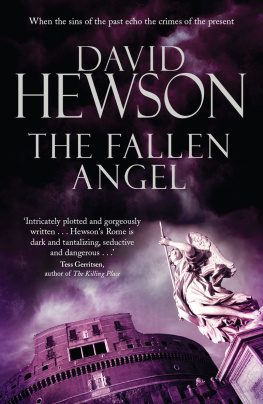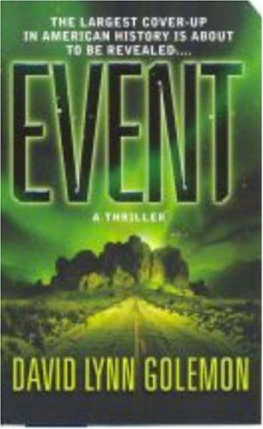ALSO BY DAVID HEWSON
-----
A Season for the Dead
The Villa of Mysteries
The Sacred Cut
The Lizard's Bite
The Seventh Sacrament
The Garden of Evil
Lucifer's Shadow
The Dante Killings
(originally Dante's Numbers)
About the Author
DAVID HEWSON is the author of eleven novels. Formerly a weekly columnist for The Sunday Times, he lives in Kent, England, where he is at work on his next crime novel, The Fallen Angel.

Author's Note
THE EVENTS AND CHARACTERS PORTRAYED HERE ARE ENTIRELY fictional. However, Operation Gladio and its networks of clandestine undercover partisans were very real and operated for two decades or more with the secret support of successive Western governments fearful of a Soviet domino effect in Europe after the Second World War.
The CIA's founder, Allen Dulles, was instrumental in the formation of Gladio, and it was his organization that paid for most of its operations in both NATO and neutral countries. Their existence was nothing more than a rumor until the 1980s, when the Italian judge Felice Casson discovered archive documents that clearly showed that some elements in the intelligence community had links with right-wing terrorist groups.
Gladio's initial brief was to provide the basis for a network of partisan opposition in the event of a Soviet takeover. Power usually devolved to those involved in the covert movements, men who, in the case of Italy, tended to be recruited from within the ranks of former fascists and the criminal classes and were often left to devise their own strategies of action.
Casson told a BBC documentary the aim was "to create tension within the country to promote conservative, reactionary social and political tendencies. While this strategy was being implemented, it was necessary to protect those behind it because evidence implicating them was being discovered. Witnesses withheld information to cover right-wing extremists."
A 1972 attack in Peteano, in Friuli-Venezia Giulia, was a rare visible example of Gladio's apparent links to terrorism in Italy. Three members of the Carabinieri died in a car bomb, which, for years, was blamed on the Italian left-wing terrorist group the Red Brigades. When Casson reopened the case, he discovered that the explosives used came from a secret Gladio arms cache. Vincenzo Vinciguerra, a former member of the neo-Fascist groups Avanguardia Nazionale and Ordine Nuovo, received a life sentence for the attack and went on to speak openly about connections between terrorism and the secret services. He claimed that he had been able to escape and hide after the outrage because of support among the Italian security community for his anti-communist stance.
Vinciguerra recalled, "A whole mechanism came into action ... the Carabinieri, the Minister of the Interior, the customs services, and the military and civilian intelligence services accepted the ideological reasoning behind the attack."
He was later to tell the Swiss historian Daniele Ganser, author of Nato's Secret Armies: Operation Gladio and Terrorism in Western Europe, "You had to attack civilians, the people, women, children, innocent people, unknown people far removed from any political game. The reason was quite simple. They were supposed to force these people, the Italian public, to turn to the state to ask for greater security. This is the political logic which remains behind all the massacres and the bombings which remain unpunished, because the state cannot convict itself or declare itself responsible for what happened."
At his trial, Vinciguerra was to add, "With the massacre of Peteano and with all those that have followed, the knowledge should by now be clear that there existed a real live structure, occult and hidden, with the capacity of giving a strategic direction to the outrages. [This structure] lies within the state itself. There exists in Italy a secret force parallel to the armed forces, composed of civilians and military men, in an anti-Soviet capacity, that is, to organize a resistance on Italian soil."
On October 24, 1990, Italian prime minister Giulio Andreotti astonished the political establishment when he finally confirmed the existence of Gladio, in testimony to an Italian senate subcommittee. Andreotti had been forced into making this admission by the discoveries of Felice Casson in the archives of the state's secret services. Gladio was, Andreotti said, a "structure of information, response, and safeguard." Some 622 civilians belonged to Gladio units in Italy. He denied that the organization had any involvement in terrorist activities, but confirmed that 127 separate arms caches used by Gladio had been dismantled. It was from one such cache that the explosives that killed the three Carabinieri officers in Peteano had originated.
According to Giulio Andreotti, all incoming Italian prime ministers were informed about Gladio. This was challenged by the former socialist prime minister Bettino Craxi, who said he only knew about the secret organization when shown a letter about it that bore his own signature. Aldo Moro, the former prime minister who was kidnapped and murdered by the Red Brigades, was closer to the political establishment of the time than Craxi, and doubtless knew of its existence. According to one of his kidnappers, Alberto Franceschini, Moro had helped set up the Gladio structure in the first place. However, Moro's keenness to embrace a reformed Communist Party in a coalition known as "the historic compromise" (compromesso storico) offended many on the right, and has proved the basis for frequent conspiracy theories surrounding his kidnap and assassination.
Some of those with possible answers did not, however, survive to give them to subsequent parliamentary inquiries. The Carabinieri general Alberto Dalla Chiesa, who led the anti-terrorist campaign in the 1970s and captured two key members of the Red Brigades, was assassinated in Palermo in 1982, along with his wife, on the orders of the Mafia boss Salvatore Rina.
Among the cases Dalla Chiesa was investigating at the time was the murder of the journalist Mauro De Mauro. According to a Mafia informant, De Mauro was killed because he had learned about the planned 1970 coup d'etat known as the Golpe Borghese, involving the right-wing "Black Prince," Junio Valerio Borghese. The plot involved the occupation of the Quirinale Palace and Ministry of the Interior by army dissidents, with the support of Mafia backers. Borghese was an aristocrat and fascist soldier who had been rescued from partisans at the end of the war by the U.S. agent James Angleton, later a long-serving chief of the CIA's counterintelligence staff. Known to many as the "mother" of the modern CIA, Angleton grew up in Rome, where his family owned a business, and returned to the city on one of his first CIA postings. Borghese fled Italy after the collapse of the plot attempt. In spite of several years of trials, no one was convicted of any crime over this very real attempt to overthrow a democratically elected European government.
A second journalist to suffer from the fallout of the "Years of Lead" was Carmine "Mino" Pecorelli, a specialist writer with extensive contacts inside the secret-service community. Pecorelli had written an article warning that Alberto Dalla Chiesa was in danger of assassination four years before the Carabinieri general was murdered. Pecorelli published a number of private documents relating to the Moro case, drawing a connection between the death of the former prime minister and Gladio. He had also linked Giulio Andreotti himself to the Mafia.








